AUDI Q7 2015 Owner´s Manual
Manufacturer: AUDI, Model Year: 2015, Model line: Q7, Model: AUDI Q7 2015Pages: 350, PDF Size: 86 MB
Page 291 of 350
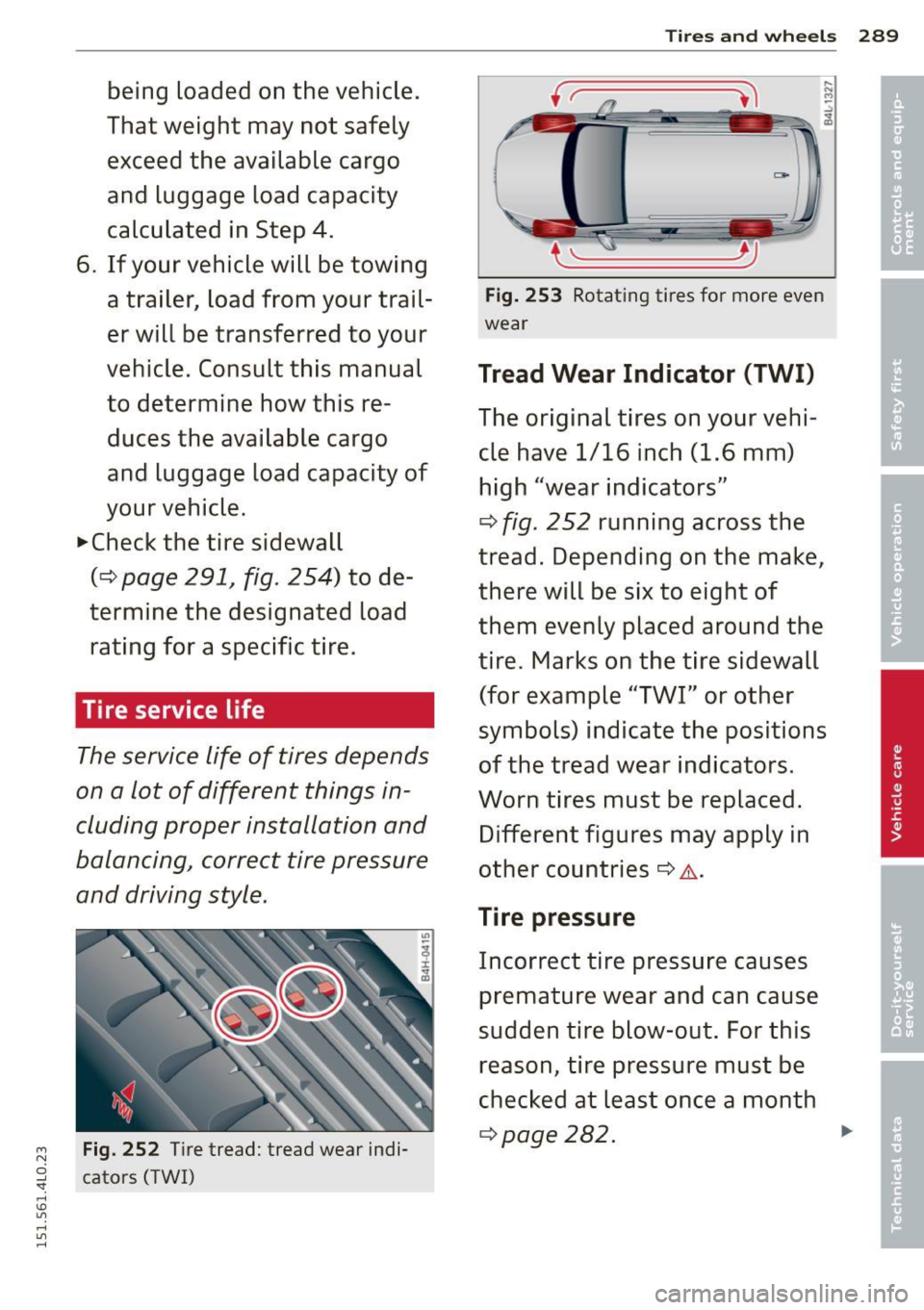
M
"' 0 ..J
""'. rl I.O
"' rl
"' rl
being loaded on the vehicle.
That weight may not safely
exceed the available cargo and luggage load capacity
calculated in Step 4.
6. If your vehicle will be towing
a trailer, load from your trail
er will be transferred to your
vehicle. Consult this manual
to determine how this re
duces the available cargo
and luggage load capacity of
your vehicle.
.,.Check the tire sidewall
(¢ page 291, fig. 254) to de
termine the designated load rating for a specific tire.
Tire service life
The service life of tires depends
on a lot of different things in
cluding proper installation and
balancing, correct tire pressure and driving style .
Fig. 252 Tire tread: tread wear indi
cators (TWI)
Tires and wheels 289
.... N M ::;;
;g
Fig. 253 Rotating tires for more even
wear
Tread Wear Indicator (TWI)
The original tires on your vehi
cle have
1/16 inch (1.6 mm)
high "wear indicators"
¢ fig. 252 running across the
tread. Depending on the make,
there will be six to eight of
them evenly placed around the
tire. Marks on the tire sidewall (for example "TWI" or other
symbols) indicate the positions
of the tread wear indicators.
Worn tires must be replaced.
Different figures may apply in
other countries
¢ & .
Tire pressure
Incorrect tire pressure causes
premature wear and can cause
sudden tire blow-out. For this
reason, tire pressure must be
checked at least once a month
¢ page 282.
Page 292 of 350
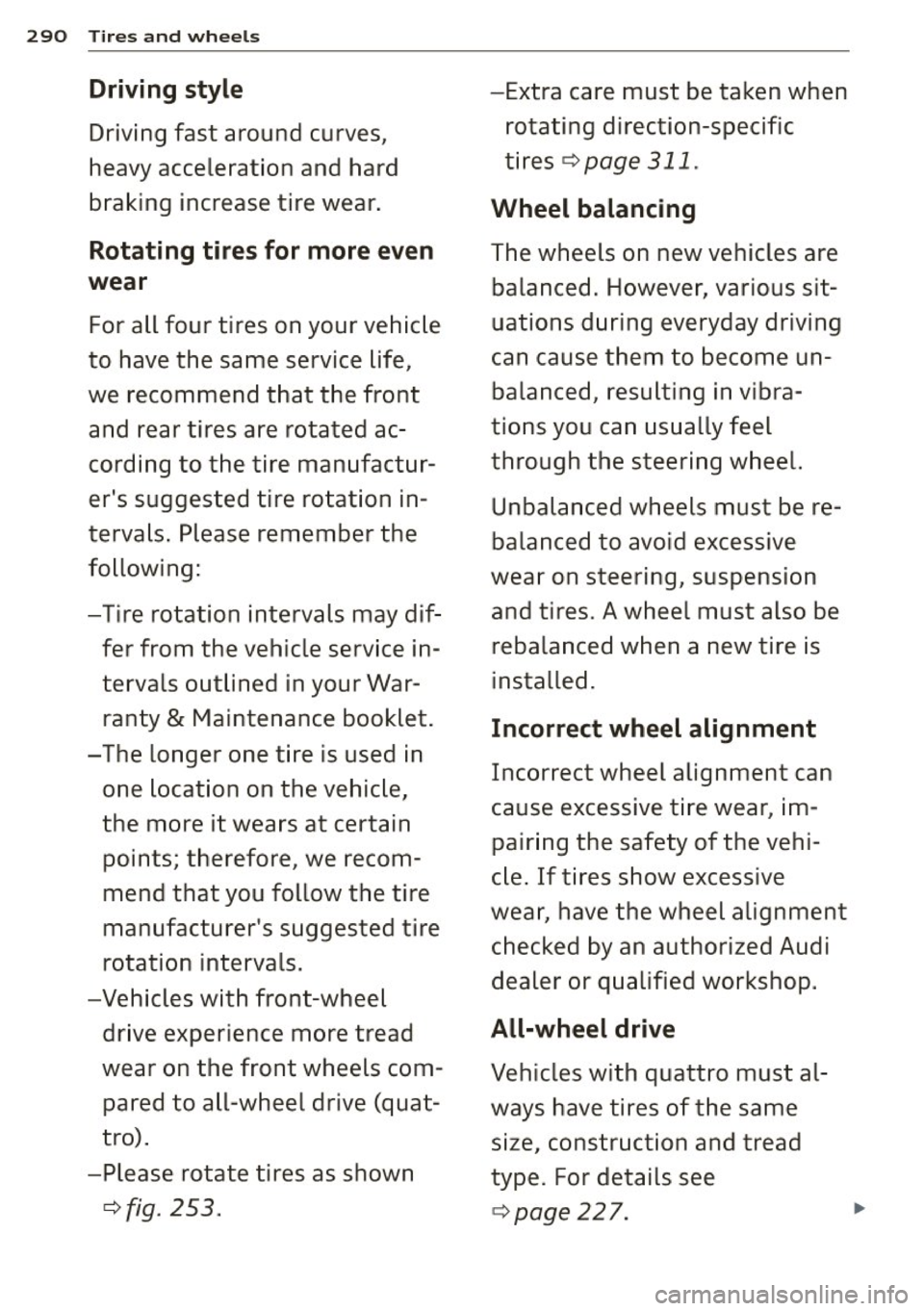
290 Tires and whee ls
Driving style - Extra care must be taken when
Driving fast around curves, rotating direction-specific
heavy acceleration and hard tires
¢
page 311.
braking increase tire wear. Wheel balancing
Rotating tires for more even
The wheels on new vehicles are
wear ba lanced. However, various sit-
For all four tires on your vehicle uations during everyday driving
to have the same service life, can cause them to become un-
we recommend that the front balanced, resulting in vibra-
and rear tires are rotated ac -tions you can usually feel
cording to the tire manufactur- through the steering wheel.
er's s uggested tire rotation in-
Unbalanced wheels must be re-
tervals . Please remember the
balanced to avoid excessive
following: wear on steering, suspension
-T ire rotation intervals may dif -and tires. A wheel must also be
fer from the vehicle service in· rebalanced when a new tire is
tervals outlined in your War -insta
lled .
ranty
& Maintenance booklet . Incorrect wheel alignment
-The longer one tire is used in
Incorrect wheel alignment can
one location on the vehic le,
cause excessive ti re wear, im-
the more it wears at certain
pairi ng the safety of the vehi-
points; t herefore, we recom-
cle . If t ires show excessive
mend that you fo llow the tire
wear, have the wheel alignment
manufacturer's suggested tire
checked by an authorized Audi
rotation interva ls.
dealer or qualified wo rkshop.
-Vehicles with front-wheel
dr ive experience more t read
All-wheel drive
wear on the front wheels com-
Vehicles with quattro must al -
pared to all-wheel drive (quat- ways have tires of the same
tro) .
size, construction and tread
-Please rotate tires as shown type. For details see
¢ fig. 253.
¢page 227. ...
Page 293 of 350

M
"' 0 ..J
"". rl I.O
"' rl
"' rl
,&_ WARNING
Sudden tire failure can lead
to loss of control, a crash and
serious personal injury!
-Never drive a vehicle when the tread on any tire is worn down to the wear indica
tors.
-
-Worn tires are a safety haz
ard, they do not grip well on
wet roads and increase your
risk of "hydroplaning" and
loss of control.
-Always keep chemicals that
can cause tire damage, such
as grease, oil, gasoline and
brake fluid away from tires.
-Tires age even if they are
not being used and can fail
suddenly, especially at high
speeds. Tires that are more
than 6 years old can only be
used in an emergency and
then with special care and
at lower speeds.
-Never mount used tires on
your vehicle if you are not
sure of their "previous histo
ry." Old used tires may have
been damaged even though
the damage cannot be seen
that can lead to sudden tire
Tires and wheels 291
failure and loss of vehicle
control.
New tires and replacing
tires and wheels
New tires and wheels hove to
be broken in.
Fig. 254 Tire specification codes on
the sidewall of a tire
No. Description
CD Passenger car tire (where
applicable)
0 Nominal width of tire in
millimeters
® Ratio of height to width
(aspect ratio)
© Radial
® Rim diameter code
Page 294 of 350
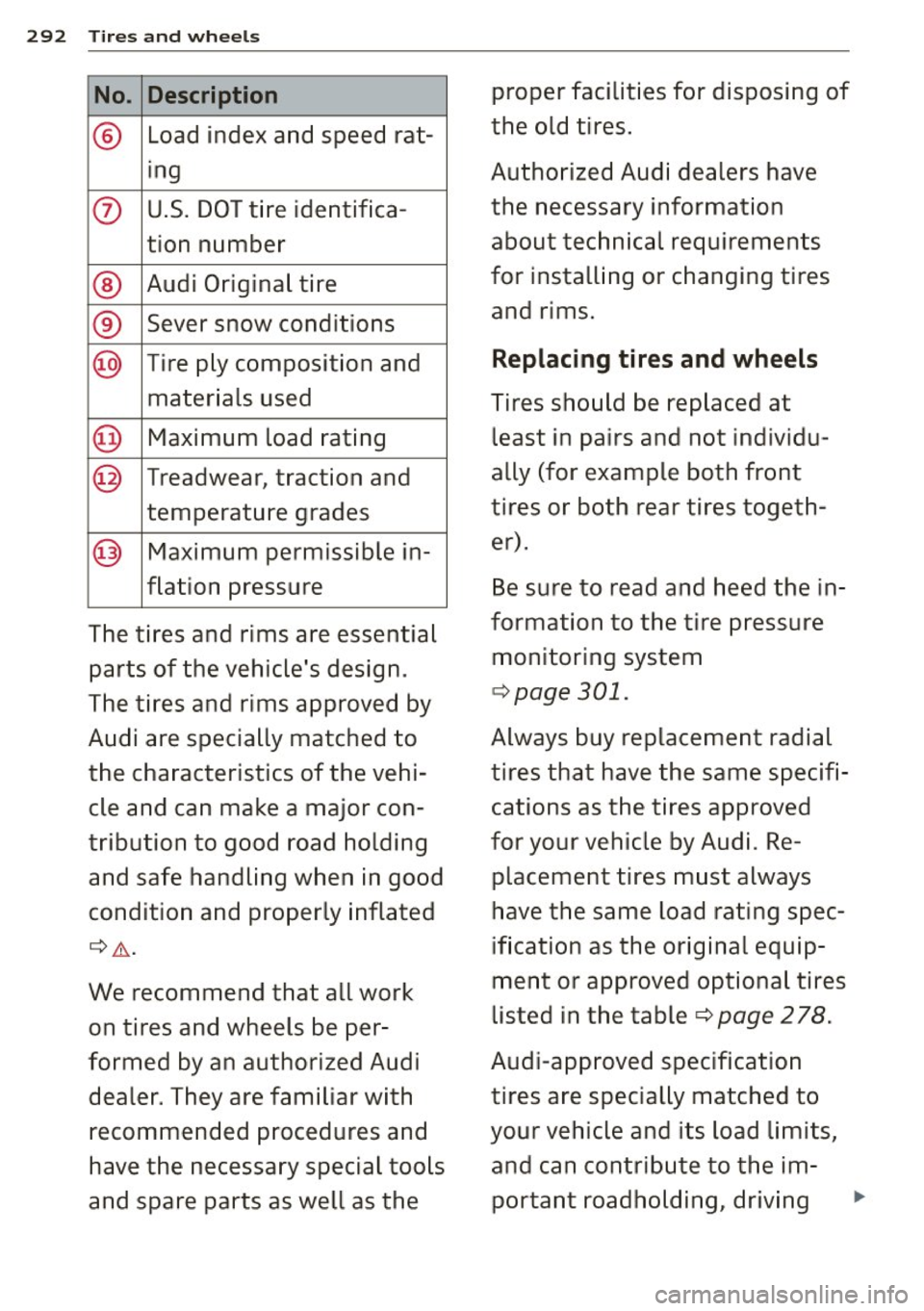
292 Tires and whee ls
No . Description
® Load index and speed rat-
ing
(J) U .S. DOT tire identifica-
tion number
® Audi Original tire
® Sever snow conditions
@ Tire ply composition and
materials used
@ Maximum load rating
@ Treadwear, traction and
temperature grades
@ Maximum permissible in-
flation pressure
The tires and rims are essential
parts of the vehicle's design .
The tires and rims approved by
Audi are specially matched to
the characteristics of the vehi
cle and can make a major con
tribution to good road holding and safe handling when in good
condition and properly inflated
¢ ,&..
We recommend that all work
on tires and wheels be per
formed by an authorized Audi
dealer. They are familiar with
recommended p rocedures and
have the necessary special too ls
and spare parts as well as the proper facilities for disposing of
the old ti res.
Autho rized Audi dealers have
the necessary information
about technical requirements
for installing or changing tires
and rims .
Replacing tires and wheels
Tires sho uld be replaced at
least in pairs and not individu
ally (for example both front
tires or both rear tires togeth
er).
B e sure to read and heed the in
formation to the tire pressure
monitoring system
c::> page 301.
Always buy replacement radial
tires that have the same specifications as the tires approved
for your vehicle by Audi. Re
placeme nt tires m ust always
have the same load rating spec
ification as the orig inal equip
ment or approved optional tires
listed in the table c::>page
278.
Audi-approved spec ificat io n
tires are specially matched to
your vehicle and its load limits ,
and can contribute to the im- portant roadholding, driving .,.
Page 295 of 350

Tires and wheels 293
characteristics, and safety of This contains the following in-•
the vehicle. The table formation: • '
(¢ page 2 78) lists specifica-p Indicates the tire is for pas-
tions of the tires approved for senger cars (where applica-
the Audi models covered by ble)
your Owner's Literature.
255 Nominal tire width in mm
The tire pressure label located of the tire from sidewall
on the driver's side B-pillar edge to sidewall edge. In
¢page 278~ fig. 251 lists the general, the larger the num-
specifications of the original ber, the wider the tire
equipment tires installed on
55 Height/width ratio in per-
your vehicle at the time it was cent (aspect ratio)
manufactured.
R Tire construction: Radial
Federal law requires tire manu-
18 Rim diameter code (in in-
facturers to place standardized ches)
information on the sidewall of
109 Load rating code
all tires ¢
fig. 254. This infor-H Speed rating letter code
mation identifies and describes
XL (or "xl", "EXTRA LOAD" , or
the fundamental characteris- "RF" Indicates that the tire is
tics, the quality grade of the a"Reinforced" or an "Extra
tire and also provides a tire Load" tire
identification number for safety
M+S (or "M/5") Indicates that
standard certification and in the tire has some mud and
case of a recall. snow capability
Tire specifications The tires could also have the in-
Knowledge of tire specifications formation of direction of rota-
tion
¢
page 2 72.
makes it easier to choose the
correct tires . Radial tires have
Tire manufacturing date
the tire specifications marked
The manufacturing date is also
M on the sidewall, for example: indicated on the tire sidewall N
0 ...J
P255 / 55 R 18 109 H XL (possibly only on the inner side 'SI: ,...., \!)
of the wheel): 1.1'1 .... ,...., 1.1'1 ,....,
Page 296 of 350
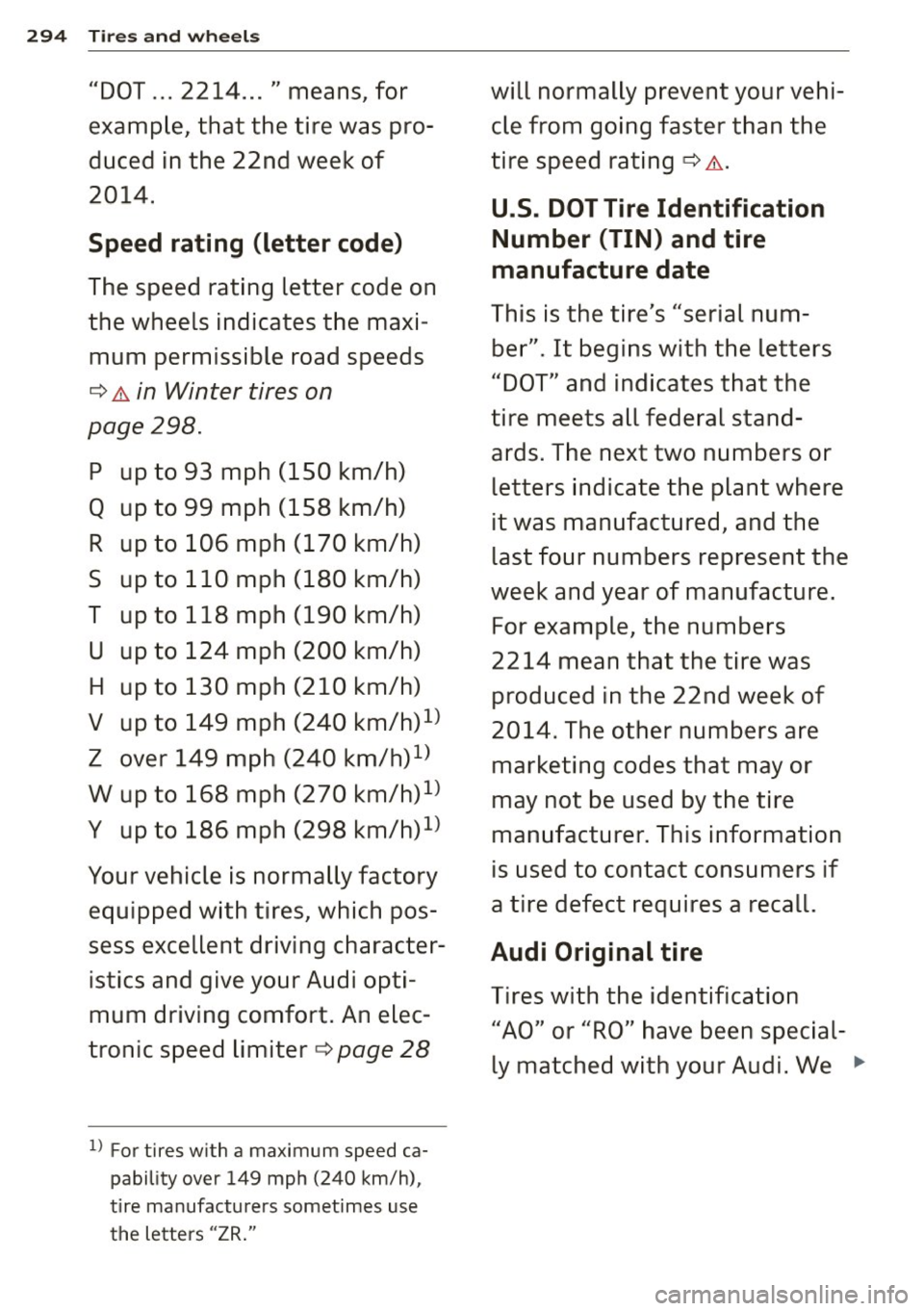
294 Tires and wheels
"DOT ... 2214 ... " means, for
example, that the tire was pro-
duced in the 22nd week of
2014.
Speed rating (letter code)
The speed rating letter code on
the wheels indicates the maxi -
mum permissible road speeds
c> & in Winter tires on
page 298.
P up to 93 mph (150 km/h)
Q up to 99 mph (158 km/h)
R up to
106 mph (170 km/h)
s up to 110 mph (180 km/h)
T up to
118 mph (190 km/h)
u up to 124 mph (200 km/h)
H up to 130 mph (210 km/h)
V up to 149 mph (240 km/h)1
)
z over 149 mph (240 km/h)1
)
W up to 168 mph (270 km/h)1
)
Y up to 186 mph (298 km/h)1
)
Your vehicle is normally factory
equ ipped with tires, which pas-
sess excellent driving character- istics and give your Audi opti-
mum driv ing comfort. An elec-
tron ic speed limiter
c> page 28
l) For t ires with a maximum speed ca
pability ov er 149 mph (240 km/h) ,
tire manufacturers sometimes use
the letters "ZR."
will normally prevent your vehi-
cle from going faster than the
tire speed rating
c> & .
U.S. DOT Tire Identification
Number (TIN) and tire
manufacture date
This is the tire's "serial num-
ber". It begins with the Letters
"DOT" and indicates that the
tire meets all federal stand- ards. The next two numbers or letters indicate the plant where
it was manufactured, and the
last four numbers represent the
week and year of manufacture. For example, the numbers
2214 mean that the tire was
produced in the 22nd week of
2014. The other numbers are marketing codes that may or
may not be used by the tire
manufacturer. This information
is used to contact consumers if
a tire defect requires a recall.
Audi Original tire
Tires with the identification
"AO" or "RO" have been special-
ly matched with your Audi. We
...
Page 297 of 350
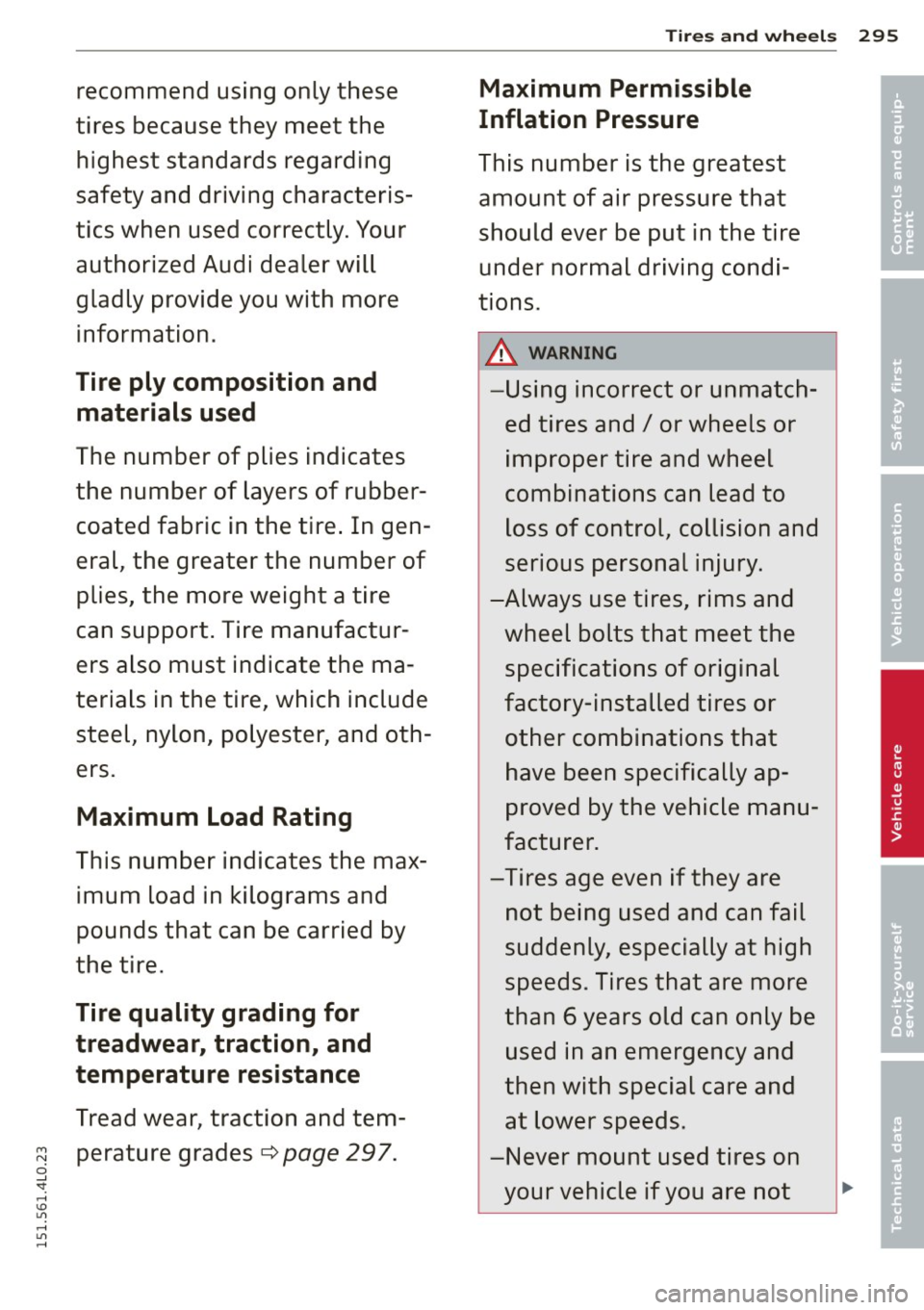
M N
0 ...J
'SI: ,...., \!) 1.1'1 ,...., 1.1'1 ,....,
recommend using only these
tires because they meet the highest standards regarding
safety and driving characteris
tics when used correctly. Your
authorized Audi dealer will
gladly provide you with more
information.
Tire ply composition and materials used
The number of plies indicates
the number of layers of rubber
coated fabric in the tire. In gen
eral, the greater the number of plies, the more weight a tire
can support. Tire manufactur
ers also must indicate the ma
terials in the tire, which include steel, nylon, polyester, and oth
ers .
Maximum Load Rating
This number indicates the max
imum load in kilograms and
pounds that can be carried by
the tire.
Tire quality grading for
treadwear, traction, and
temperature resistance
Tread wear , traction and tem
perature grades ¢
page 297.
Tires and wheels 295
Maximum Permissible
Inflation Pressure
This number is the greatest
amount of air pressure that
should ever be put in the tire under normal driving condi
tions.
A WARNING
- Using incorrect or unmatch
ed tires and/ or wheels or
improper tire and wheel
combinations can lead to
loss of control, collision and
serious personal injury.
-Always use tires, rims and wheel bolts that meet the specifications of original
factory-installed tires or
other combinations that have been specifically ap
proved by the vehicle manu
facturer.
-Tires age even if they are not being used and can fail
suddenly, especially at high speeds. Tires that are more
than 6 years old can only be
used in an emergency and
then with special care and at lower speeds.
-Never mount used tires on your vehicle if you are not
•
•
'
Page 298 of 350
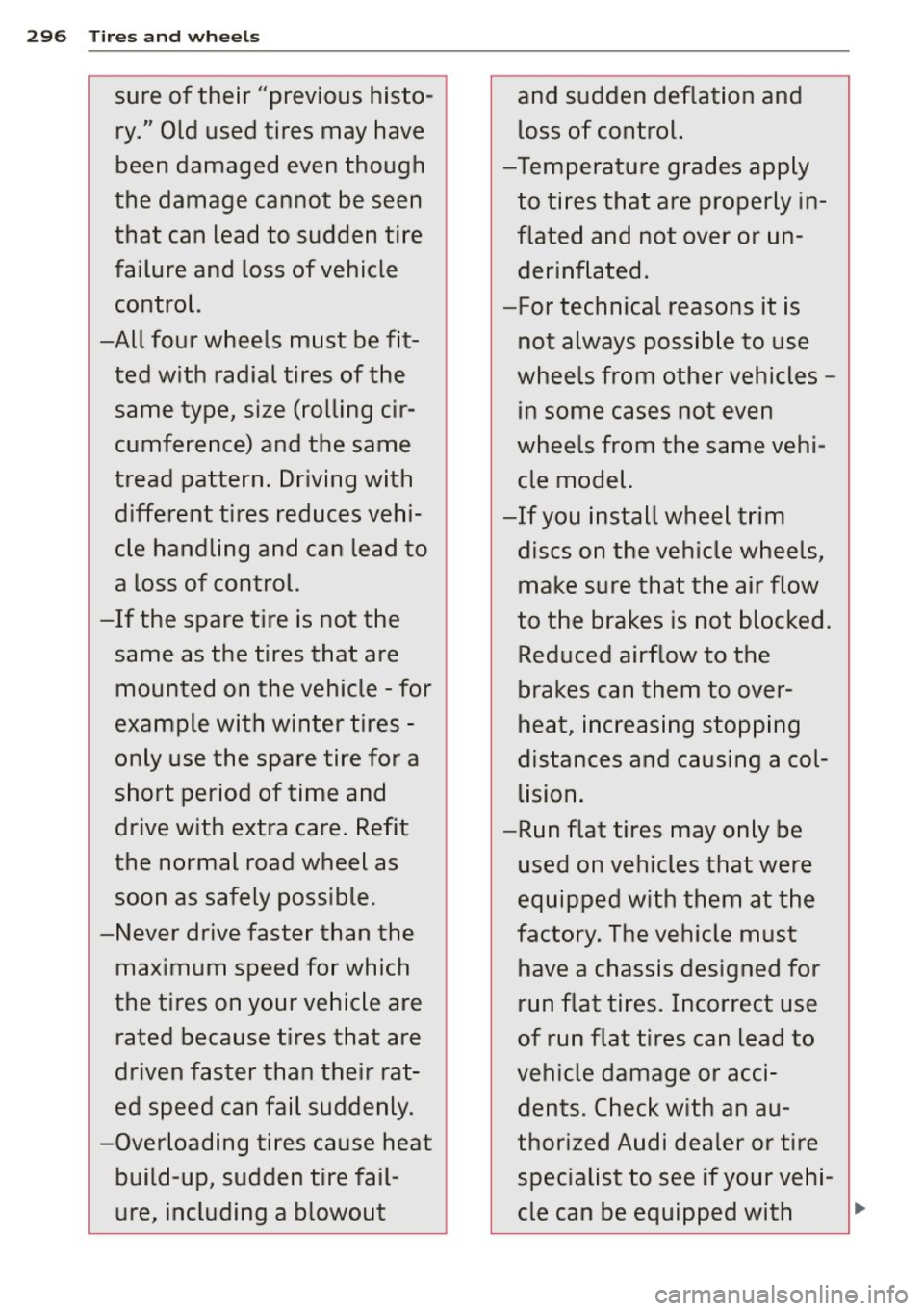
296 Tires and wheels
sure of their "previous histo-
and sudden deflation and
ry." Old used tires may have loss of control.
been damaged even though -Temperature grades apply
the damage cannot be seen to tires that are properly in-
that can lead to sudden tire flated and not over or un-
failure and loss of vehicle
derinflated.
control. -For technical reasons it is
-All four wheels must be fit-
not always possible to use
ted with radial tires of the wheels from other vehicles -
same type, size (rolling cir- in some cases not even
cumference) and the same wheels from the same vehi-
tread pattern. Driving with cle model.
different tires reduces vehi- -If you install wheel trim
cle handling and can lead to
discs on the vehicle wheels,
a loss of control. make sure that the air flow
-If the spare tire is not the to the brakes is not blocked.
same as the tires that are Reduced airflow to the
mounted on the vehicle -for
brakes can them to over-
example with winter tires -
heat, increasing stopping
only use the spare tire for a distances and causing a col-
short period of time and lision.
drive with extra care. Refit -Run flat tires may only be
the normal road wheel as used on vehicles that were
soon as safely possible. equipped with them at the
-Never drive faster than the
factory. The vehicle must
maximum speed for which have a chassis designed for
the tires on your vehicle are run flat tires. Incorrect use rated because tires that are of run flat tires can lead to
driven faster than their rat-
vehicle damage or acci-
ed speed can fail suddenly. dents. Check with an au-
-Overloading tires cause heat thorized Audi dealer or tire build-up, sudden tire fail- specialist to see if your vehi-
ure, including a blowout cle can be equipped with
..
Page 299 of 350
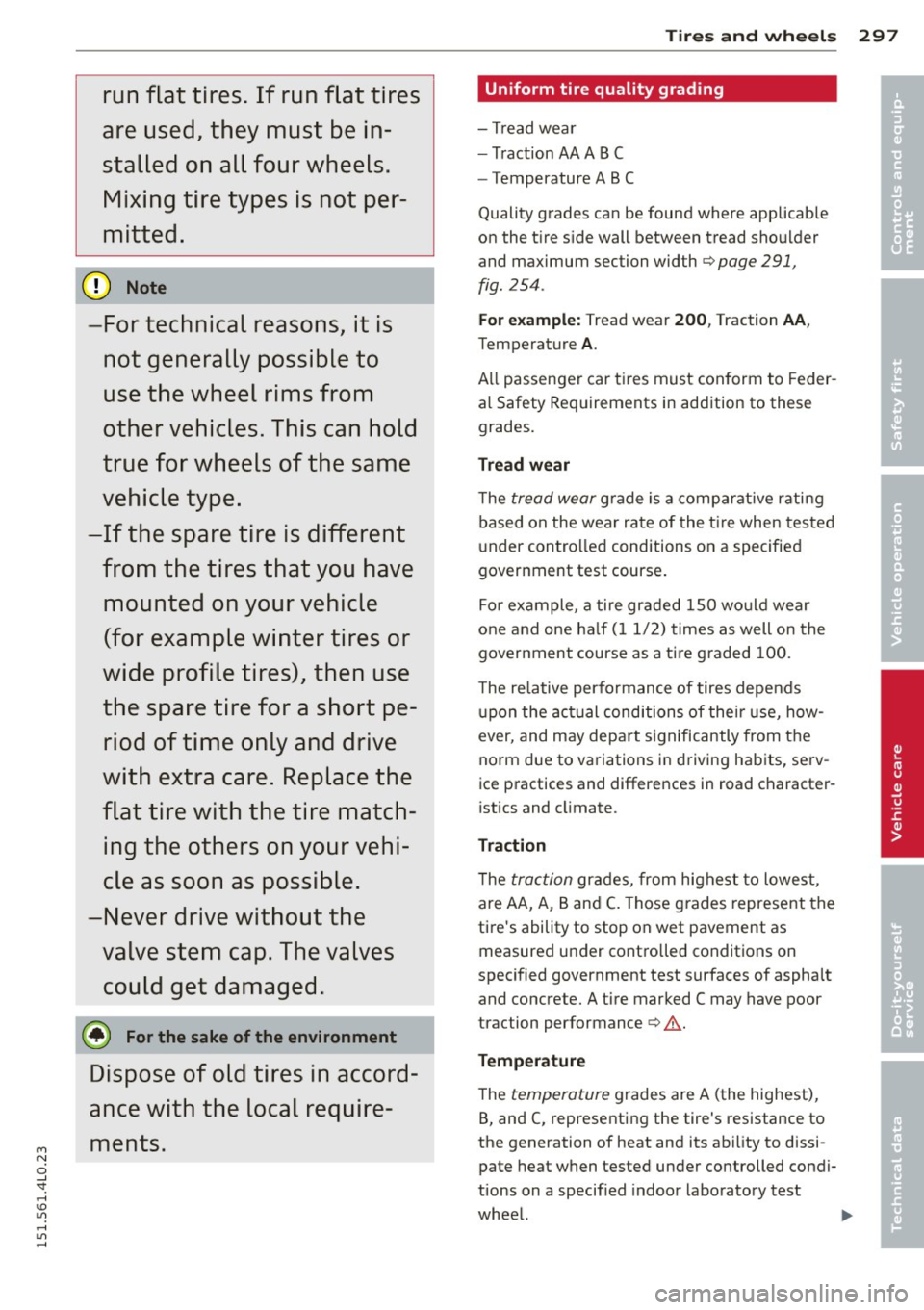
M N
0 ...J
'SI: ,...., \!) 1.1'1 ,...., 1.1'1 ,....,
run flat tires. If run flat tires
are u sed , they must be in
stalled on all four wheels. Mixing tire types is not per
mitted.
(D Note
-For technical reasons, it is not generally possible to
use the wheel rims from
other vehicles. This can hold
true for wheels of the same
vehicle type.
- If the spare tire is different
from the tires that you have mounted on your vehicle
(for example winter tires or
wide profile tires), then use
the spare tire for a short pe riod of time only and drive
with extra care. Replace the
flat t ire with the tire match
ing the others on your vehi
cle as soon as possible.
- Never drive without the
valve stem cap. The valves
could get damaged .
@) For the sake of the environment
Dispose of old tires in accord
ance with the local require ments.
Tires and wheels
Uniform tire quality grading
- Tread wea r
- Traction AA A B C
- Temperature AB C
Quality g rades ca n be foun d where applicab le
on the t ire s ide wall between t read sho ulder
and maximum section width
c> page 291,
fig. 254 .
For example : Tread wear 200, Traction AA,
Temperat ure A .
All passenge r ca r tir es must con form to Feder
a l Safety Requ irements in add ition to these
grades.
Tread wear
T he tread wear g rade is a c omp arati ve rati ng
based on the wear ra te of the tire when tes te d
u nder con tro lled conditions o n a specifie d
government test course .
F o r ex ample , a tire gr aded 1S 0 wo uld wear
one a nd one h alf ( 11/ 2) times as well on the
governmen t course as a ti re g raded 100 .
T he re lative perfo rman ce of tires depe nds
up on the actu al c ondition s of the ir u se, how
ever, and m ay depa rt s ignificantly from t he
no rm due to va ria tions i n driving ha bits, se rv
ice p ractices and differences in road character
istics and cl imate.
Traction
T he trac tio n gr ad es, from hig hest to lowes t,
a re AA, A, Ban d
C. Those g rades represe nt the
ti re 's ability to stop on wet pavement as
measured u nder cont rolled conditions on
specified government test surfaces of aspha lt
and concrete. A t ire mar ked C may have poor
traction performance
c> ,&. .
Temperature
The temperature gr ades are A (the highest),
B, and C, represent in g the tire's resistance to
the generation of heat and its ab ility to d issi
pate heat when tested un der controlled condi
tions on a specif ied indoo r labo rato ry test
whee l.
297
•
•
Page 300 of 350
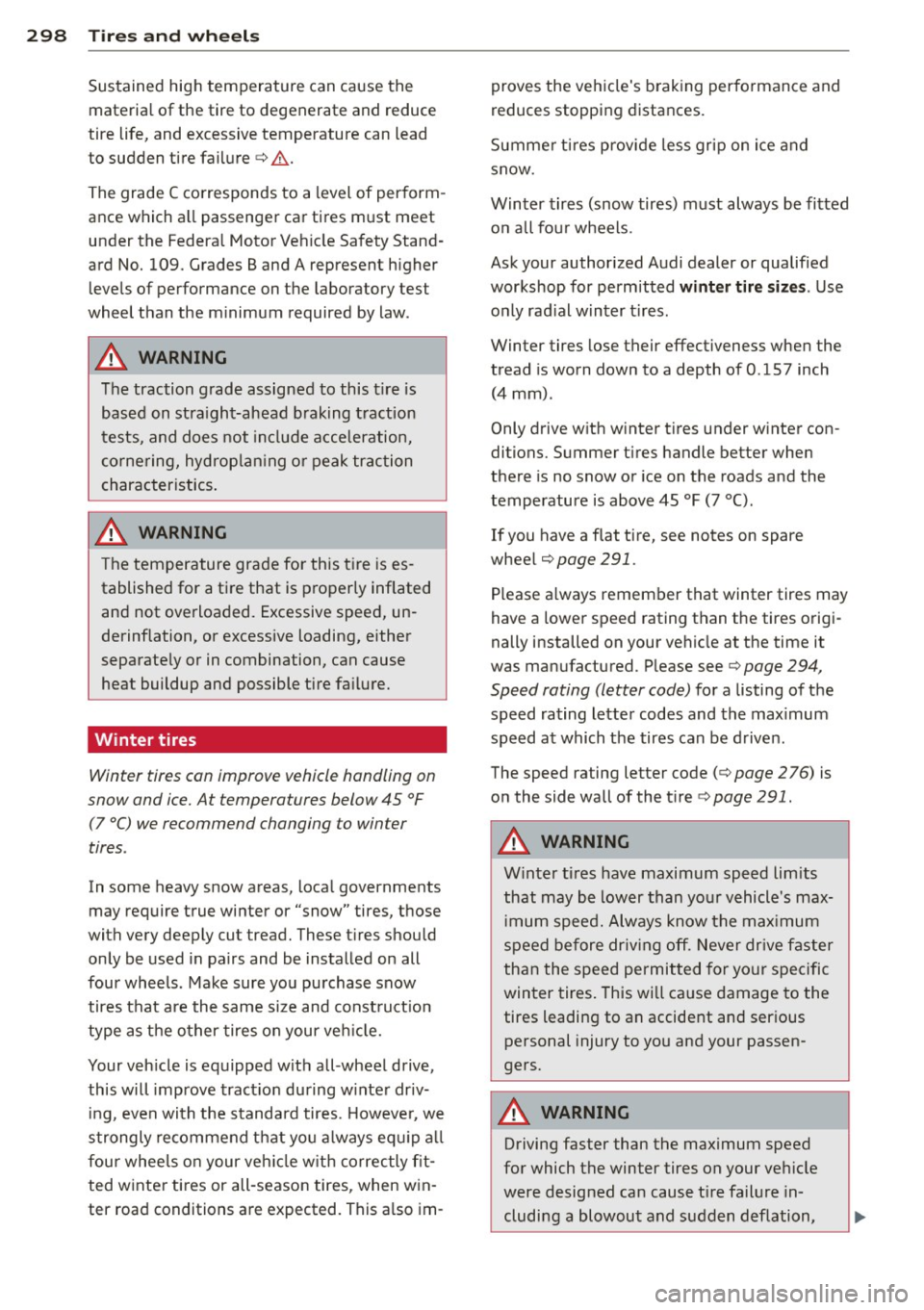
298 Tires and wheels
Sustained high temperature can cause the
materia l of the tire to degenerate and reduce
tire life, and excessive temperature can lead
to sudden tire failure<=>,& .
The grade C corresponds to a level of perform
ance which a ll passenger car tires must meet
under the Federa l Motor Veh icle Safety Stand
ard No.
109. Grades Band A represent higher
levels of performance on the laboratory test
wheel than the minimum required by law.
A WARNING
The traction grade assigned to this t ire is
based on stra ight-ahead braking traction
tests, and does not include acceleration,
cornering, hydroplanin g or peak traction
characteristics.
A WARNING ,.,.____
The temperature grade for this tire is es
tablished for a tire that is properly inflated
and not overloaded. Excessive speed, un
derinflation, or excessive loading, either
separately or in combination, can cause heat buildup and possible tire fa ilure.
Winter tires
Winter tires can improve vehicle handling on
snow and ice. At temperatures below 45 °F
(7 °C) we recommend changing to winter
tires .
In some heavy snow areas, loca l governments
may require true winter or "snow" tires, those
with very deeply cut tread. These t ires should
only be used in pairs and be installed on all
four wheels. Make sure you purchase snow
tires that are the same size and construct ion
type as the other tires on your ve hicle.
Your veh icle is equipped with all -wheel drive,
this will improve traction during w inter driv
i ng, even with the standard tires. However, we
strongly recommend that you always equip all
four whee ls on your veh icle w ith correctly fit
ted winter ti res or all-season tires, when win
ter road conditions are expected. This a lso im- proves the vehicle's
braking performance and
reduces stopping distances.
Summer tires provide less gr ip on ice and
snow.
Winter tires (snow tires) must always be fitted
on all four wheels.
Ask your authorized Audi dealer or qualified
workshop for perm itted
winter tire sizes . Use
only rad ial winter t ires .
Winter tires lose their effectiveness when the
tread is worn down to a depth of
0.157 inch
(4 mm).
Only drive w ith w inter t ires under winter con
ditions. Summer t ires handle better when
there is no snow or ice on the roads and the
temperature is above 45 °F (7 °() .
If you have a flat tire, see notes on spare
wheel<=>
page 291 .
Please always remember that winter tires may
have a lower speed rating than the tires origi
nally installed on your vehicle at the time it
was manufactured. Please see
<=>page 294,
Speed rating (letter code)
for a listing of the
speed rating letter codes and the maximum
speed at which the tires can be driven .
The speed rating letter code (<=>
page 2 76) is
on the side wall of the t ire
c> page 291.
A WARNING ,.___
Winter tires have maximum speed limits
that may be lower than your vehicle's max
imum speed. Always know the maximum
speed before driv in g off. Never drive faster
than the speed permitted for your specific
winter tires. This wi ll cause damage to the
tires leading to an accident and serious
personal injury to you and your passen
gers.
A WARNING
'----
Driving faster than the maximum speed
for which the winter tires on your vehicle were designed can cause t ire failure in
cluding a blowout and sudden deflation,